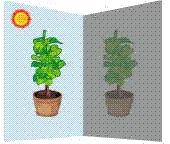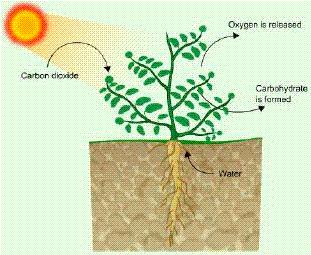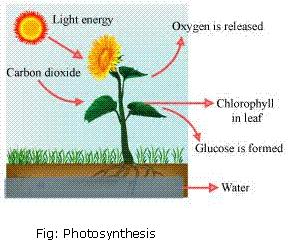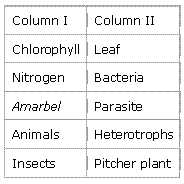NCERT Solution for Class 6 Science Chapter 1 - Nutrition in Plants
All living organisms require food to survive because of the following reasons:
i.It gives energy to perform various activities. All activities such
as playing, running, walking, studying, etc. require energy. The various
components present in our food such as carbohydrates and fats provide
energy to our body.
ii.Some components like minerals and vitamins are important for growth and development of the body.
Concept insight: Organisms need food to produce energy for growth and development.
|
Parasite |
Saprotroph |
|
i. The organism that grows on the body of another organism and derives nutrients from it is known as a parasite.
ii. Parasites absorb prepared food from the host.
Example of parasites are cuscuta and orchids. |
i. The organism that obtains nutrients from the dead or decaying organic matter is called saprotroph.
ii. Saprotrophs digest food outside the body and absorbs digested food.
Example of saprotrophs are fungi and some bacteria. |
Concept insight: Parasites absorb prepared food the host. Saprotrophs digest food outside the body and absorbs digested food.
સારા માર્ક મેળવવા માટે સૌ પ્રથમ આ પાઠનો વિડીયો જુઓ ત્યારબાદ ટેસ્ટ આપો
વિડીયો ભાગ 1
દરેક પ્રશ્ન માટે તમારી પાસે 30 સેકન્ડ નો સમય હશે.
નીચેના બોક્સમાં તમારું નામ લાખો
QUIZ CERTIFICATE
This is to Certify that Ms. . Has attended MCQ Quiz exam on //.
Total Question of exam : .Attempted Question:
Corrct answers:
Worng Answer :
Total obtainaid percentage is .
Over all result is


શેર કરો
Experiment to test the presence of starch in leaves:
i. Take two healthy green potted plants of the same type.
ii. Keep one potted plants in a dark room for one or two days in order to remove all the starch from the leaves.
iii. Keep the other plant in sunlight.
iv. Now, take one leaf from each potted plant and put a few drops of iodine solution on them.
v. Note down the change in the colour of both the leaves.
Observation: No blue-black colour will be observed on the leaves of plant kept in the dark room. This indicates the absence of starch. Blue-black colour will be observed on the leaves of the plant kept in sunlight. This indicates the presence of starch.
Concept insight: Plants prepare glucose during photosynthesis which gets stored in plants in the form of starch. Iodine turns blue-black when reacted with starch.
Photosynthesis is defined as the process in which the chlorophyll- containing plant cells synthesize food in the form of carbohydrates, using carbon dioxide and water in the presence of solar energy.
Sources of raw materials required for photosynthesis:
(a) Water is taken in, from the roots of the plant and is transported to the leaves.
(b) Carbon dioxide from the air enters the leaves through the pores called stomata and diffuses to the cells containing chlorophyll.
(c) Solar energy is used to break water into hydrogen and oxygen. This hydrogen is combined with carbon dioxide to form food for the plants, which is ultimately used by the animals as well.
Thus , photosynthesis can be represented by the following equation.
Concept insight: Photosynthesis is the process through which plants prepare their food.
Concept insight: Recall the process of photosynthesis.
Green plants are called __autotrophs__ since they synthesize their own food.
(b) The food synthesized by the plants is stored as __starch__.
(c) In photosynthesis solar energy is captured by the pigment called chlorophyll__.
(d) During photosynthesis plants take in __carbon dioxide__ and release oxygen.
Concept insight: Recall the process of photosynthesis
(i) Cuscuta
(ii) Pitcher plant
(iii) Stomata
Concept insight: Nutrition in plants
(a)Amarbel is an example of
(ii) parasite
(b)The plant which traps and feeds on insects is
(iii) pitcher plant
Concept insight: Recall the modes of nutrition in plants
Concept insight: Recall the modes of nutrition in plants
(i) Carbon dioxide is released during photosynthesis. (F)
Concept insight: Oxygen is released during photosynthesis.
(ii) Plants which synthesize their food themselves are called saprotrophs. (F)
Concept insight: Saprotrophs are organisms which feed on dead and decaying matter.
(iii) The product of photosynthesis is not a protein. (T)
Concept insight: The product of photosynthesis is a carbohydrate.
(iv) Solar energy is converted into chemical energy during photosynthesis. (T)
Concept insight: As solar energy is used to prepare starch from carbon dioxide and water so solar energy is converted into chemical energy.
NCERT Solution for Class 6 Science Chapter 1 - Nutrition in Plants Page/Excercise 10
(ii) Stomata
Concept insight: Recall the process of photosynthesis.
(iv) leaves
Concept insight: Recall the process of photosynthesis.
Green house protects the plants to inside from the climatic conditions outside and gives it suitable temperature for growth. The advantages to the farmers are:
(i) It protects crops from many diseases
(ii) It also protects the plant from heavy winds and rodents.











Post a Comment
Post a Comment